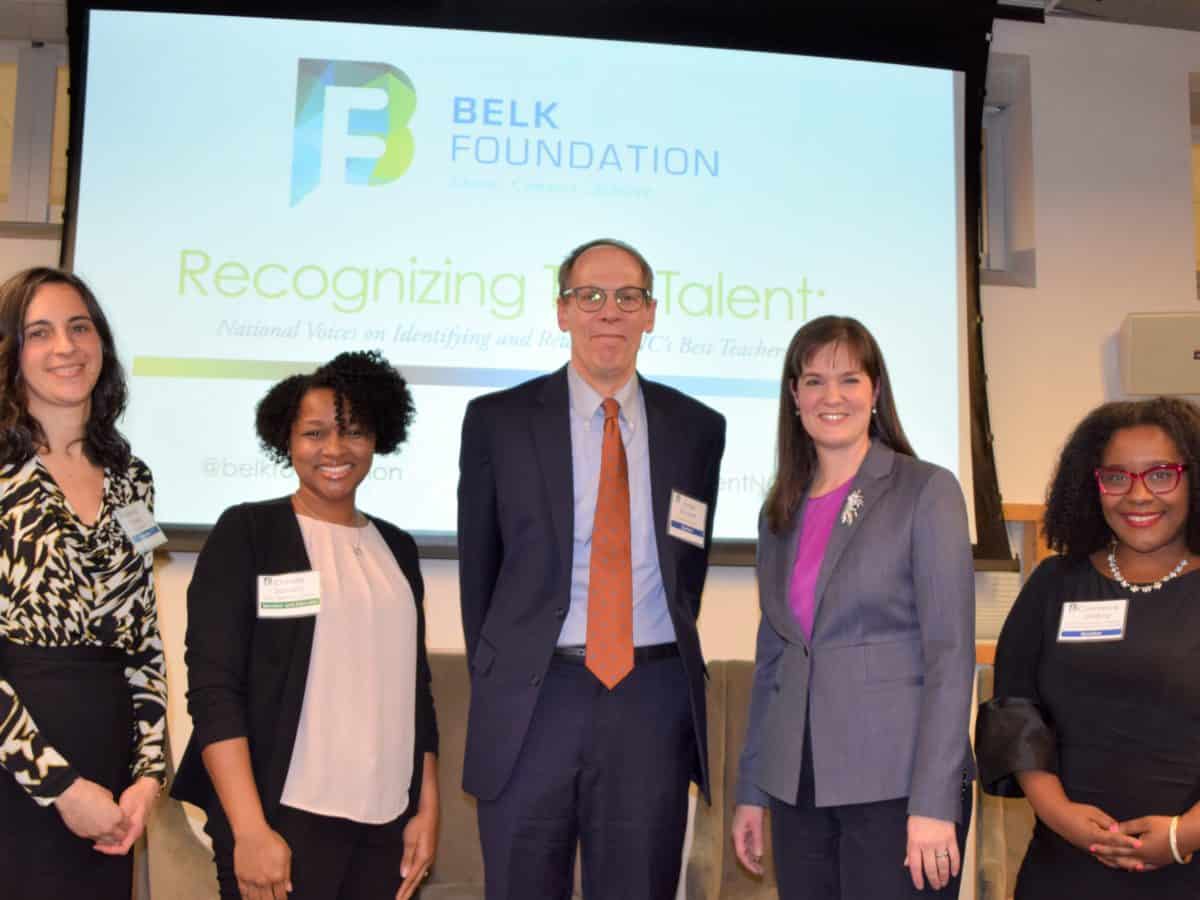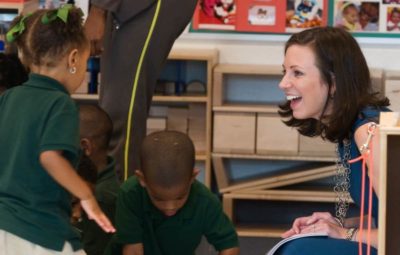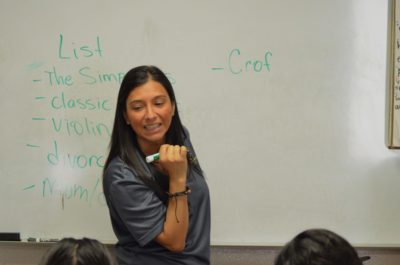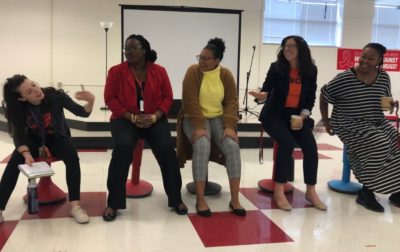

Cherelle Sanders is a multi-classroom leader at Martin Millennium Academy in Tarboro. In her first year in that role, she worked with four teachers. One was in her third year teaching, but the other three were all brand new.
“Not only were they brand new to teaching but they had no formal education in teaching,” she said.
If that seems “alarming,” Sanders said, the important thing to remember is that they were getting coached and supported by an effective teacher: her.
“At the end of the 2018 school year I was excited to see, to share, to celebrate that all four teachers exceeded growth,” said Sanders.
#TeacherTalentNC
On Wedenesday, The Belk Foundation brought together educators, policymakers, and experts to discuss best practices and how North Carolina can get and keep effective teachers in its classrooms. It started with an understanding that teachers are the single biggest indicator of student success.
“Identifying and retaining our best teachers in North Carolina is a central question for our schools and should be one of our state’s highest priorities. Teachers are the most important in-school factor on students’ academic success,” said John R. Belk, board chair of The Belk Foundation. “Our most talented teachers in North Carolina are the difference makers who can connect with students and contribute to their academic achievement.”
At the event, a panel of experts fielded questions on how to evaluate teachers to determine who is effective, what can be done to keep and retain them, and what we’ve learned from years of research on the subject of identifying effective teachers.
“There are more than 100,000 teachers in North Carolina. We know there are effective teachers in all our communities across the state. By sharing leading research and policy levers, the panelists will point to promising ways to retain top educators in our state,” said Johanna Anderson, executive director of The Belk Foundation.
The panelists included Constance Lindsay, an assistant professor of Educational Leadership in the School of Education at the University of North Carolina at Chapel Hill; Candice McQueen, chief executive officer of the National Institute for Excellence in Teaching and former commissioner of education in Tennessee; and James Wyckoff, professor of education and policy and director of EdPolicyWorks, a research center at the University of Virginia.
They began by discussing what experts have learned from years of research into how to identify effective teachers. Many states use a variety of measures, including value-added tools such as EVAAS here in North Carolina, observational evaluations, and even student survey results.
Wyckoff began by setting the stage for why this work is important.
“Teachers are the single most important factor that impact student outcomes in schools,” he said, adding later: “It’s really important I think that we understand how to measure that effectiveness in ways that are fair to the teachers and in ways that are fair to the kids.”
He said that value-added measures such as EVAAS have strengths and weaknesses. While they help show how students are improving, teachers’ effectiveness on such measures can often vary year by year. They are more effective as a long-term measure, and he said programs like EVASS have a lot of the qualities that leaders want in an evaluation system.
Wyckoff said, when you ask a principal in a school who the most effective teachers are, they can easily identify them. Comparing what principals say to what value-added measures show often yield similar results.
While that may be the case, the complaint that’s heard from teachers is that while value-added measures may accurately reflect the reality, they don’t give teachers any sense of how to get better, he said.
That’s where observational evaluations come into play. Having a trained observer assess teachers multiple times a year has been shown to be valid and reliable, Wyckoff said, and overlaps with what value-added measures show. But there is a catch.
“Doing that well on a consistent basis is challenging and requires lots of focus on implementation,” he said.
McQueen said that having multiple measures in place for evaluating teachers is essential. She also said it’s important that measures outside of the value-added ones must be vetted by teachers so that they understand what they are and what benchmarks they are supposed to meet.
She described measures such as EVAAS as a “black box,” which is to say that teachers don’t exactly understand how it determines their effectiveness or lack thereof. So it’s important that other evaluation measures make sense to them.
“If they don’t understand that — what those other measures are, how you’re getting there — then it becomes a lightning rod,” said McQueen.
When schools, districts, or the state are discussing what measures will come into play in evaluating teachers, McQueen said teachers — particularly teacher leaders — need to be at the table.
Lindsay cautioned that when it comes to teacher evaluations, implementation is key. If not implemented correctly, these measures can have unintended consequences when it comes to things like having a diverse workforce or retaining teachers. She said that reforms in some states around teacher evaluation have had adverse impacts, such as making it hard to fill jobs at high-needs schools.
McQueen said that one key to measures such as teacher observation is an understanding on the part of evaluators as to what criteria constitutes good instruction. In particular, how principals understand that since they are the ones usually doing the observation.
Her organization has been helping districts set up systems that put these criteria in place, coaching principals on what instruction looks like at different levels. She said evaluating a teacher’s effectiveness isn’t as simple as walking into a classroom and seeing that the teacher is in control and students are listening. They have to be able to judge if the techniques teachers are using are actually effective ones.
Through McQueen’s organization, principals can actually get certified to show that they have a solid grasp of how to evaluate teachers and judge their effectiveness, rather than expecting that they will just know.
She said systems like that can be instituted at the state level and scaled effectively in ways that benefit everyone.
Wyckoff, who has worked on this issue with Washington, D.C. public schools, said that this “calibration” is critical. As D.C. tried to implement an observational evaluation system, they brought in full-time evaluators for the first seven years. These were people who worked in the content area of the teachers they were observing. Teachers would be observed five times — three by the principal and twice by the evaluators. And then the results would be measured against each other to see if there were discrepancies.
“If you’re going to invest in observation, you want to invest heavily to make sure you do it right,” he said. “And there are a number of states in my opinion who have not made that investment.”
The panelists talked about how teacher evaluation can be critical to the retention of top talent in schools.
Wyckoff said that compensation can be used as a carrot to get effective teachers into high-poverty schools. In D.C., for example, he said that bonuses are almost only for teachers who teach in high-poverty schools.
McQueen said that compensation can be effective, but districts and schools need to think strategically about how to use it. It’s important to think about what goals are trying to be achieved, and then map compensation strategies onto those goals to achieve the desired outcome.
“If you are trying to attract, retain, or promote effective … teachers, then how do you think about resources and how does compensation fit into that?” she said.
She also said it’s important to look at realities on the ground. In Tennessee, she said, they found that bonuses could be effective in some districts, but they could also be counterproductive depending on the culture in a community and the goals the community was trying to promote.
Some strategies involve giving extra money to teacher leaders if you’re hoping to create a pathway forward for teachers that enables growth. Those teachers can stay connected to teaching, if that’s what they want to do, or move into a pipeline that could lead to administration. McQueen said paying for effective teaching can also be useful, but that it’s important in that case to make sure that “effective teaching” is well-defined and understood.
“We’re all trying to figure this out. But there are so many lessons learned now from districts and states that have tried it,” she said. “When it didn’t work and people rolled it back, it had everything to do with implementation.”
When it comes to getting effective teachers into the classroom, Lindsay said that centralized hiring systems that screen candidates and present top talent for consideration can be helpful. But, at the end of the day, it’s up to the principals to hire the top talent. The process can fall apart if principals don’t follow through on the information they’re given.
Wyckoff said that outside of compensation, sometimes very simple strategies can promote teacher retention. Something as easy as recognizing effective teachers can go a long way to making teachers feel useful and valued.
Key takeaways on teacher talent
“Thinking about diversity doesn’t mean you have to undermine quality. I think we can achieve the goals of having a high-quality workforce that is also diverse and well prepared to teach lots of different kids,” said Lindsay.
“Teacher evaluation done well works well,” Wyckhoff said. “It can fail … and it fails most often because of bad implementation.”
“That alignment across what’s the district expecting and what’s actually happening in teacher prep — and creating the tools and the pipeline to get there — has to be a national conversation number one, but North Carolina should lead that conversation,” said McQueen.
Editor’s Note: The Belk Foundation is a Charlotte-based family foundation that supports public education by strengthening teachers and school leaders, and ensuring that students are achieving on or above grade level by the third grade. Now in its fourth generation of family leadership, The Belk Foundation serves as the public expression of gratitude and commitment shown by the family that created the Belk department store organization. The Belk Foundation had assets of more than $52 million as of September 30, 2017. Since 2000, The Belk Foundation has invested more than $46 million in our state. The Belk Foundation supports the work of EducationNC.




